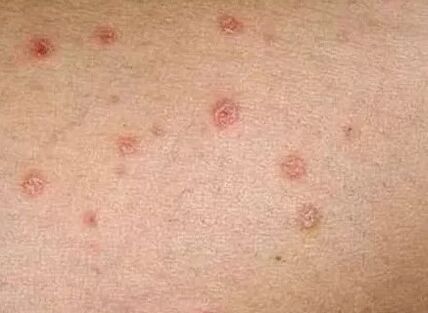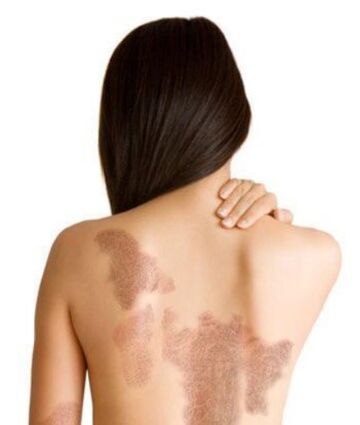Despite the unknown psoriasis etiology and the factors that cause it, its developmental stage is well studied.The classification of psoriasis at the stage facilitates the assessment of the disease, helps identify sensitivity to certain methods of treatment and determining the patient's tactics.

The level of psoriasis is classified depending on the nature of the severity (or the activity of the inflammatory process) and the severity.
The level of psoriasis depends on the problem
Psoriasis is a disease that has 3 stages:
- progressive;
- stationary;
- Retrogressive;
- forgiveness.
Symptoms of progressive stage
This level is characterized by clear signs.Double rash appears on the skin, has a red nodules (papules, tubercles) that have oval or round shapes.They combine and form focus that occupy a large area, the surface is actively peeling, the patient at the same time has severe itching on the skin, and sometimes the burning sensation.Itching can be exhausting and disturbing the patient, not only during normal life, but even in dreams, itching is to intensify when contacting clothes.After a scale, the surface can be wet and turns into a nutrient medium for bacterial spread.
The main manifestations of the progressive stage are:
- appearance of papul on the surface of the body and body;
- The combination of papules to conglomerate ("plaque"), has white;
- peel the surface of the conglomerate;
- There is no scale in the plaque edge, but there is a hyperemic rim;
- Plaque edges are compacted;
- The presence of the phenomenon of the hemorrhage: When mechanical damage (cuts, scratches) appears on uninhabited skin, new psoriatic plaques are formed in place.
The more intense during the progressive levels of the skin is, the more active inflammation.The most dangerous effects of psoriasis are psoriatic arthritis, while severe articular pain occurs, as a result, defective joints.

Symptoms of stage stage
With the onset of stationary stages, the gradual weakness of the enlargement process occurs.At the same time, papules become pale, they turn from red to pink, new rash during this period does not appear.The knot surface has a "plaque" form, it is compact, covered with crust, represented by many dry skin scales.The healing properties of papules start from center to edge.The presence of psoriasis psoriasis confirms the effectiveness of the treatment.
The main manifestations of this stage are:
- lack of new papul rash;
- Existing plaques stop their growth;
- The surface of the plaque is covered with a scale;
- Red rims disappear around smooth plaques;
- The phenomenon is lost.
Symptoms of regression level
At the regression stage, the process is proud."Plaque" is resolved, forming a skin decomposition area.Itching -The skin is gradually disappearing, the sign of peeling decreases.
Signs -Psoriasis regression sign:
- There are voronov rims around the plaque (dense ring folds located around the psoriatic plaque);
- gradually reduction and loss of peeling;
- At the plaque site, decomposition areas (white or dark) are formed.
At the regression stage, the plaque is completely lost, the residue of the plaque is possible in the area: knee, elbow, stomach, buttocks.
Pardon
Remission is a clear level of recovery.During forgiveness, psoriasis is in a state of "sleep", but does not disappear from the body.Psoriasis forgiveness lasts until the next severity (progressive level).

It should be noted that during the oppression of psoriasis, a person's general condition does not change, he goes to work, engages in the normal household matters.Psoriasis only brings aesthetic and cosmetic defects to a person: the skin of the patient has a lot of scratches, one cannot wear open clothing, if the problem is observed in the summer, one cannot visit the pool, go to massage, cosmetic procedures, etc.
The level of psoriasis depends on the wound area
The severity of psoriasis also depends on the skin lesion area.Therefore, at a slight level, only 3%of the skin surface is affected, with average - from 3 to 10%, and with heavy - more than 10%.Psoriasis, which causes damage to the joints, belongs to severe levels, where the skin lesions are not taken into account.You can measure your own damage area.For this purpose, open palm regulations are used (skin areas that match the human palm area are 1% of the entire surface of the body).
Pasi index
The general system for assessing the severity of psoriasis is evaluated using the pasi index, which includes a common assessment and severity, as well as the severity of the manifestation of the disease.This indicator is estimated from 0 to 72. At the same time, light psoriasis levels have less than 10 indicators, average - from 10 to 20, more than 20. Using the pasi index, the effectiveness of clinical treatment is also calculated.
In addition to different levels, psoriasis can have different types: seborrheic, exudative, plantar, intertriginous, old, rupioid, stopped, nail psoriasis and mucous membranes.It is not possible to cure psoriasis completely, but you can achieve long forgiveness.It is the goal of modern treatment methods.























